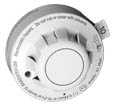|
Apollo manufactures intrinsically safe (IS) detectors
in both the Series 60 and
XP95
ranges. This is because there are many places where an
explosive mixture of air and gas or vapour is or may
be present continuously, intermittently or as a result
of an accident. These are defined as hazardous areas
by BS 5345:1976, the code of practice for installation
and maintenance of electrical apparatus in potentially
explosive atmospheres.
Hazardous areas are common in petroleum and chemical
engineering plants and in factories processing and
storing gases, solvents, paints and other volatile
substances.
Electrical equipment for use in these areas needs to
be designed so that it cannot ignite an explosive
mixture, not only in normal operation but also in
fault conditions. The two most common ways to achieve
this are flameproof enclosures and intrinsic safety.
Flameproof equipment is contained in a box so strong
that an internal explosion will neither damage the box
nor be transmitted outside the box. The surface must
remain cool enough not to ignite the explosive mixture. |
 |
When
flameproof equipment is interconnected, flameproof wiring
must be used. This method is most valuable when high power
levels are unavoidable but it is not acceptable for areas
in which an explosive gas/air mixture may be continuously
present or present for long periods.
For this
reason, Apollo fire detectors are made intrinsically safe
rather than flameproof. Intrinsically safe equipment
operates at such low power and with such small amounts of
stored energy that it is incapable of causing ignition:
- in
normal conditions
- with a
single fault
- with a
combination of any two faults
In any of
these conditions, every component must remain cool enough
not to ignite the gases for which it is approved.
Click
here
for product literature.
|